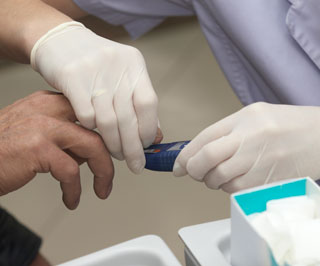 Image credit: Picsfive/Thinkstockphotos.com
Image credit: Picsfive/Thinkstockphotos.com
Point-of-care testing (POCT) has become a foundation in today's global healthcare system. New and innovative technologies allow diagnostic tests to leave the confines of the core laboratory and migrate to the site of patient care, speeding the delivery of results and enabling more immediate diagnosis and care.
However, POCT in lieu of lab-based testing brings its own challenges and still requires considerable oversight by laboratory staff, given the potential implications for patient care.
Attendees at the 68th AACC Annual Scientific Meeting & Clinical Lab Expo will have many opportunities to brush up on POCT analytics and regulatory requirements and better understand emerging uses of POCT. The Annual Meeting Organizing Committee has highlighted several such sessions in the POCT Topic Track.
Sunday
AACC University: The Impact of Pre-analytical Variables on Critical Care Point-of-Care Testing
The primary purpose of POCT is to generate results quickly for immediate intervention, which is vital in critical care. As in central laboratories, however, pre-analytical variability poses a challenge. This session presents common variables that may have an impact on critical care testing (blood gases, co-oximetry, potassium, ionized calcium) and methods to reduce the potential for such errors.
This AACC University course requires an additional fee: $215 for members; $235 for non-members
AACC University: Expanding Point-of-Care Testing in Healthcare Systems for Patient-Centered Care
This program, developed together with the AACC Critical and Point-of-Care Testing Division, highlights the dynamism of the POCT field with interactive discussions on key considerations for new POCT requests and essential managerial tools for high-level quality assurance and regulatory compliance.
This AACC University course requires an additional fee: $270 for members; $290 for non-members
Monday
Chair’s Invited Session: mHealth
Mobile health, or mHealth, is the practice of medicine supported by mobile devices. It includes the use of devices linked to mobile phones, health-related apps, and mobile-assisted communication.
“I think that mHealth as it develops provides more flexibility into the delivery of healthcare,” said Annual Meeting Organizing Committee (AMOC) chair William Clarke, PhD, DABCC, of the Johns Hopkins University School of Medicine in Baltimore, who also chairs this session. “It can empower home healthcare providers with more information at the point of need, and it also provides more options for healthcare delivery in remote areas and developing countries.”
Among the topics covered in this session are mHealth-related diagnostics, which, Clarke said, complement what will be offered in clinical labs. Thus, he continued, “I don’t think there are negative implications of mHealth for laboratorians, but opportunities to focus on higher acuity testing as some routine testing shifts out of central labs.”
mHealth also provides opportunities to explore how a combination of remote and central lab testing can be leveraged to provide the best care for patients, he concluded.
Oral Abstract Session: POCT-Utilization, QA/QC and Advances in Technologies
To ensure clinical laboratory professionals have the most up-to-date knowledge about POCT, the AMOC chose several abstracts from those accepted as part of the AACC Annual Scientific Meeting to be discussed in oral presentations. Each 15-minute presentation will be followed by a 5-minute question-and-answer session.
This session occurs from 2:30 p.m. – 4 p.m.
Wednesday
Evaluating the Hypoxemic Patient: Oxygen and Oxygen-Related Parameters Used in Critical Care Settings
Clinical laboratorians are often not familiar with how partial pressure of oxygen, oxygen saturation, hemoglobin, and other measurements are used to calculate oxygen-related parameters, and how clinicians use these variables to evaluate and monitor hypoxemia, pulmonary ventilation, and perfusion in critically ill patients.
In this session, John Toffaletti, PhD, and Craig Rackley, MD, both of Duke University Health System, will provide clinical, pathophysiological, and practical information to help attendees understand the important pre-analytical factors in these measurements, including how to interpret oxygen and oxygen-related calculations for diagnosing and managing patients in critical care settings.